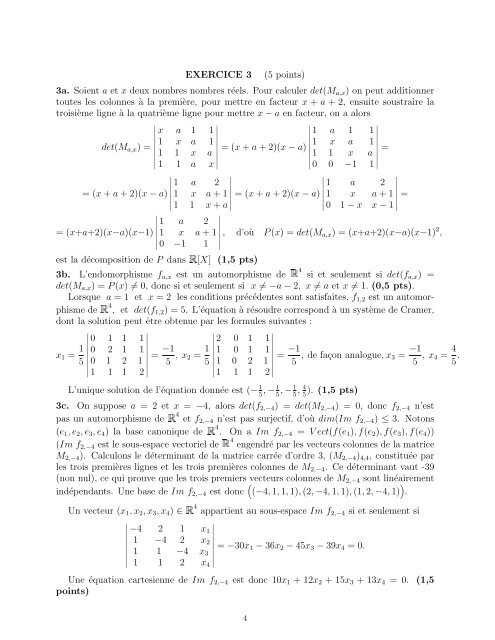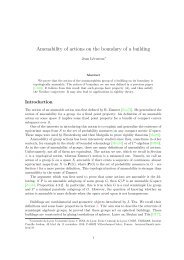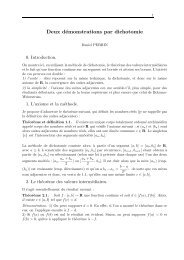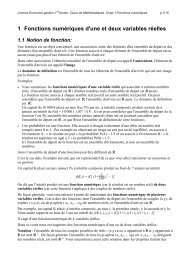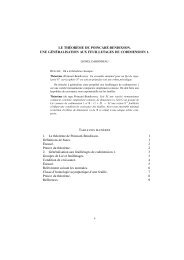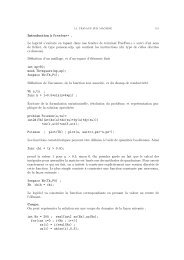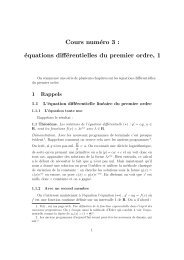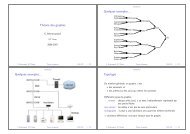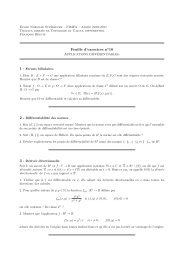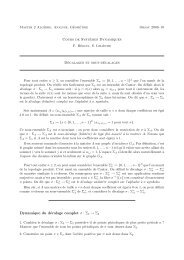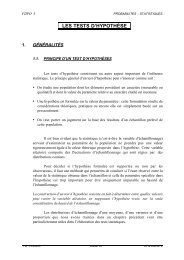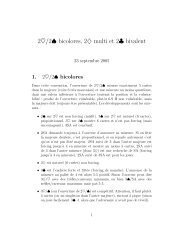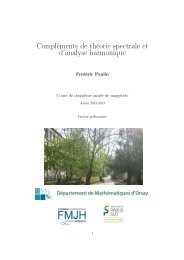Corrigé - Département de Mathématiques d'Orsay
Corrigé - Département de Mathématiques d'Orsay
Corrigé - Département de Mathématiques d'Orsay
Create successful ePaper yourself
Turn your PDF publications into a flip-book with our unique Google optimized e-Paper software.
EXERCICE 3 (5 points)<br />
3a. Soient a et x <strong>de</strong>ux nombres nombres réels. Pour calculer <strong>de</strong>t(Ma,x) on peut additionner<br />
toutes les colonnes à la première, pour mettre en facteur x + a + 2, ensuite soustraire la<br />
troisième ligne à la quatrième ligne pour mettre x − a en facteur, on a alors<br />
<br />
<br />
x<br />
<br />
1<br />
<strong>de</strong>t(Ma,x) = <br />
1<br />
<br />
1<br />
a<br />
x<br />
1<br />
1<br />
1<br />
a<br />
x<br />
a<br />
<br />
<br />
1 <br />
<br />
<br />
1<br />
1<br />
<br />
<br />
<br />
1<br />
= (x + a + 2)(x − a) <br />
a <br />
1<br />
<br />
<br />
x <br />
0<br />
a<br />
x<br />
1<br />
0<br />
1<br />
a<br />
x<br />
−1<br />
<br />
1 <br />
<br />
1<br />
<br />
<br />
=<br />
a <br />
<br />
1 <br />
<br />
<br />
1<br />
<br />
= (x + a + 2)(x − a) 1<br />
<br />
1<br />
a<br />
x<br />
1<br />
<br />
<br />
2 <br />
<br />
<br />
1<br />
<br />
<br />
a + 1 = (x + a + 2)(x − a) 1<br />
<br />
<br />
x + a <br />
0<br />
a<br />
x<br />
1 − x<br />
<br />
2 <br />
<br />
<br />
a + 1 =<br />
<br />
x − 1 <br />
<br />
<br />
1<br />
<br />
= (x+a+2)(x−a)(x−1) 1<br />
<br />
0<br />
a<br />
x<br />
−1<br />
<br />
2 <br />
<br />
<br />
a + 1 ,<br />
<br />
1 <br />
d’où P (x) = <strong>de</strong>t(Ma,x) = (x+a+2)(x−a)(x−1) 2 ,<br />
est la décomposition <strong>de</strong> P dans [X] (1,5 pts)<br />
3b. L’endomorphisme fa,x est un automorphisme <strong>de</strong> 4 si et seulement si <strong>de</strong>t(fa,x) =<br />
<strong>de</strong>t(Ma,x) = P (x) = 0, donc si et seulement si x = −a − 2, x = a et x = 1. (0,5 pts).<br />
Lorsque a = 1 et x = 2 les conditions précé<strong>de</strong>ntes sont satisfaites, f1,2 est un automorphisme<br />
<strong>de</strong> 4 , et <strong>de</strong>t(f1,2) = 5. L’équation à résoudre correspond à un système <strong>de</strong> Cramer,<br />
dont la solution peut être obtenue par les formules suivantes :<br />
x1 = 1<br />
<br />
<br />
0<br />
<br />
0<br />
<br />
5 0<br />
<br />
1<br />
1<br />
2<br />
1<br />
1<br />
1<br />
1<br />
2<br />
1<br />
<br />
1 <br />
<br />
<br />
1 <br />
=<br />
1 <br />
<br />
2 <br />
−1<br />
5 , x2 = 1<br />
<br />
<br />
2<br />
<br />
1<br />
<br />
5 1<br />
<br />
1<br />
0<br />
0<br />
0<br />
1<br />
1<br />
1<br />
2<br />
1<br />
<br />
1 <br />
<br />
<br />
1 <br />
=<br />
1 <br />
<br />
2 <br />
−1<br />
5 , <strong>de</strong> façon analogue, x3 = −1<br />
5 , x4 = 4<br />
5 .<br />
L’unique solution <strong>de</strong> l’équation donnée est (− 1<br />
5<br />
, − 1<br />
5<br />
, − 1<br />
5<br />
4 , ). (1,5 pts)<br />
5<br />
3c. On suppose a = 2 et x = −4, alors <strong>de</strong>t(f2,−4) = <strong>de</strong>t(M2,−4) = 0, donc f2,−4 n’est<br />
pas un automorphisme <strong>de</strong> 4 et f2,−4 n’est pas surjectif, d’où dim(Im f2,−4) ≤ 3. Notons<br />
(e1, e2, e3, e4) la base canonique <strong>de</strong> 4 . On a Im f2,−4 = V ect(f(e1), f(e2), f(e3), f(e4))<br />
(Im f2,−4 est le sous-espace vectoriel <strong>de</strong> 4 engendré par les vecteurs colonnes <strong>de</strong> la matrice<br />
M2,−4). Calculons le déterminant <strong>de</strong> la matrice carrée d’ordre 3, (M2,−4)4,4, constituée par<br />
les trois premières lignes et les trois premières colonnes <strong>de</strong> M2,−4. Ce déterminant vaut -39<br />
(non nul), ce qui prouve que les trois premiers vecteurs colonnes <strong>de</strong> M2,−4 sont linéairement<br />
indépendants. Une base <strong>de</strong> Im f2,−4 est donc <br />
(−4, 1, 1, 1), (2, −4, 1, 1), (1, 2, −4, 1) <br />
.<br />
Un vecteur (x1, x2, x3, x4) ∈ 4 appartient au sous-espace Im f2,−4 si et seulement si<br />
<br />
<br />
−4<br />
<br />
1<br />
<br />
<br />
<br />
1<br />
1<br />
2<br />
−4<br />
1<br />
1<br />
1<br />
2<br />
−4<br />
2<br />
<br />
x1<br />
<br />
<br />
<br />
x2 <br />
= −30x1 − 36x2 − 45x3 − 39x4 = 0.<br />
x3 <br />
<br />
x4<br />
<br />
Une équation cartesienne <strong>de</strong> Im f2,−4 est donc 10x1 + 12x2 + 15x3 + 13x4 = 0. (1,5<br />
points)<br />
4


